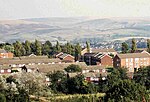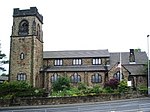St John the Baptist's Church, Smallbridge
19th-century Church of England church buildingsAnglican Diocese of ManchesterChurch of England church buildings in Greater ManchesterChurches completed in 1834Commissioners' church buildings ... and 6 more
Former churches in Greater ManchesterGothic Revival architecture in Greater ManchesterGothic Revival church buildings in EnglandGrade II listed churches in the Metropolitan Borough of RochdaleLewis Vulliamy buildingsUse British English from September 2013

St John the Baptist's Church is in Halifax Road, Smallbridge, Rochdale, Greater Manchester, England. It is a redundant Anglican parish church in the benefice of Wardle and Smallbridge, the deanery of Rochdale, the archdeaconry of Rochdale, and the diocese of Manchester. The church is recorded in the National Heritage List for England as a designated Grade II listed building. It was a Commissioners' church, having received a grant towards its construction from the Church Building Commission.
Excerpt from the Wikipedia article St John the Baptist's Church, Smallbridge (License: CC BY-SA 3.0, Authors, Images).St John the Baptist's Church, Smallbridge
Wheelwright Drive,
Geographical coordinates (GPS) Address Nearby Places Show on map
Geographical coordinates (GPS)
| Latitude | Longitude |
|---|---|
| N 53.6338 ° | E -2.132 ° |
Address
Wheelwright Drive
OL16 2QQ , Hurstead
England, United Kingdom
Open on Google Maps







